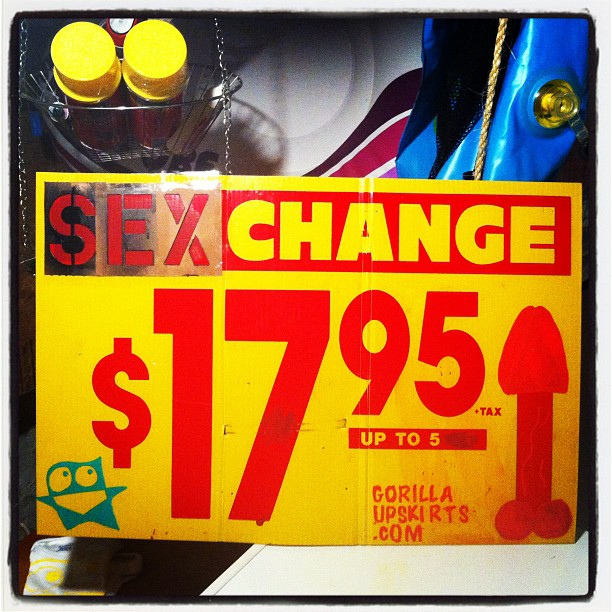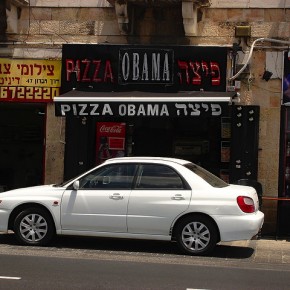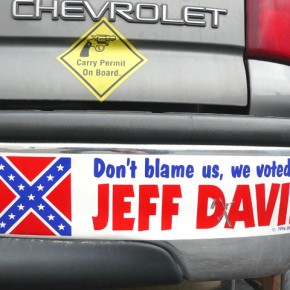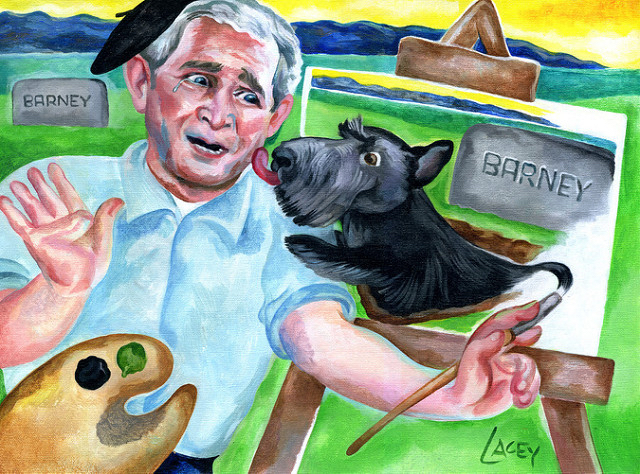It’s really easy to overlook a bandit sign. Just a few words of text and a telephone number, pasted to telephone poles in poor neighborhoods, advertising a roofing company, or the number of someone who’ll pay cash for your home or car, they prey on the needy. Bandit signs are also an eyesore, creating more trash in already heavily polluted parts of American cities. And they’re illegal.
Though my own home town of Philadelphia has worked to remove bandit signs signs, and fine those responsible, they’re still ubiquitous. Thousands of them remain visible, as though in defiance of the law. But what if, instead of taking them down, the signs were augmented in a way that both calls attention to them as well as completely disrupts their original use? What if they were turned into street art?
That’s the mission of self-described culture jammer Huggie Butterworth, a South Philadelphia-based artist who has been “disturbing the peace” in his words and putting up altered signs for the last couple years.
Huggie was first inspired to do street art while living in Ecuador during a stint in the Peace Corps. It was an election year and the walls were covered in flyers urging votes for different candidates. He decided to mess with people and make his own, which was an homage of sorts to Ecuador’s only gold medal winner, the speedwalker Jefferson Perez: “I made real shitty quality just like 8×10 paper [copies] of Jefferson Perez crossing the finish line and made a fake number for him and it said in Spanish, ‘Walking very fast-ly to a better future.’” The positive reaction to this made him want to do more.
His first augmented bandit sign came soon after his return to Philadelphia. He had been putting up stickers and various wheatpastes but, “nothing really with a message” according to him. After repeatedly seeing a sign advertising a skydiving company – “It was next to a little bodega and there’s trash on there and it’s just ‘skydive’ and I was shocked. Who would call up that number if you’re going to go skydiving?!” – he decided to do something. He stole that sign and changed the message to, “Skydive, cause South Philly isn’t scary enough.” That was the tipping point, he said.
These days Huggie goes out a few times a month to put up new signs. He told Souciant that he has about forty ready to go in his basement at any given time. According to Huggie, the point of the altered or hijacked signs is to raise awareness. “Advertising is not really bad,” he said. “It can prey on people, but I think what’s worse is blindly accepting things. Just seeing everything that’s in front of you and just not thinking about it.” His hope is to inspire people to take control of their neighborhoods.

One such inspiration came in the form of two women who responded to an anti-litter sign Huggie put up by a garbage-strewn lot. A picture of the sign, which was a takeoff on a popular Philadelphia tourist campaign and reads, “With love, dear citizens, thanks for respecting everyone else and clean up your trash”, was posted to Reddit. The women, who were Reddit users, did exactly that, and posted a picture of the cleared area to the site. Huggie was both shocked and impressed that this happened. According to the artist, it made him realize that, “there is power in things like that.”
While the above incident is political in nature, Huggie stressed that his aim is not necessarily that. “I don’t get into politics with it, but without a doubt you can’t help it. Some of the signs are political, and just fucking with people is political.” That the bandit signs themselves are aimed at poor neighborhoods, a population historically taken advantage of by outside powers, definitely factors into this. The hijacked sign might push someone to look into alternatives to the exploitative economy – cheque cashing places instead of banks, outside developers flipping properties for cash instead of owners going through brokers, and the such – that exists in these neighborhoods.

Huggie lives and mostly puts up his hijacked signs in neighborhoods that are being gentrified. He told Souciant that he does not necessarily view gentrification as a problem, that it’s more the issue of power and who holds it that changes neighborhoods for the worst. “The sad thing is if both [old and new residents] could work together they could use each other’s resources to improve the neighborhood and make a rich diverse tapestry of people,” he said. “Classes on tax laws could be set up (to save houses from foreclosure,) and the fight for better schools would impact all neighbors.”
Asked how he chooses the message for his signs, Huggie said that he rarely goes into things with a specific wording or image in mind, but rather tries to work with whatever is already on the sign. “I am happiest when I find a sign that I can leave most of the original message,” he said. An example of that is his “We Hex Houses” sign. The problem with that is that he’s then, “at the mercy of whatever signs I can pull down.” The other way of doing it is to write on the back of the signs: “This gives me the freedom to convey different ideas and even touch on socially relevant or political issues.” As far as location goes, he tries and puts the sign up where he found it or in a high-traffic area.

Being a street artist is very important to what Huggie does. “Part of our game is that we do it because we like art, we do it because we like to express ourselves, and we’re a little vain,” he explained. “Messing with the status quo, disturbing the peace is how movements start, is how revolutions start.” For Huggie, street art is important because it is open to everyone as both critic and artist, and because, “graffiti artists know the city better than taxi drivers.”
The nature of messaging and culture jamming is central to Huggie’s work. According to the artist, that means, “taking the status quo, the norm, and twisting it just enough. I realized recently that if I twist it just a little bit – before I’d have outlandish things – it just stays up longer, though it may be a bit harder to see.” This also allows the viewer to interpret the message for themselves rather than, “spoonfeeding them, kinda like what culture might do.”
Huggie believes that his hijacked signs are not necessarily claiming public space, like traditional graffiti does, but rather reclaiming it. A wall covered in tags and different images and messages is proclaiming that the area belongs to the artists and, more often than not, a group within the neighborhood. Gang tags are a good example of this. On the other hand, taking something like bandit signs that are already viewed as litter and then turning them into art and messages – and by that removing their messaging power as outside advertisements from people who don’t live in those neighborhoods – is taking that space back.
Photographs courtesy of Huggie Butterworth and Yoni Kroll. All rights reserved.






Love it!